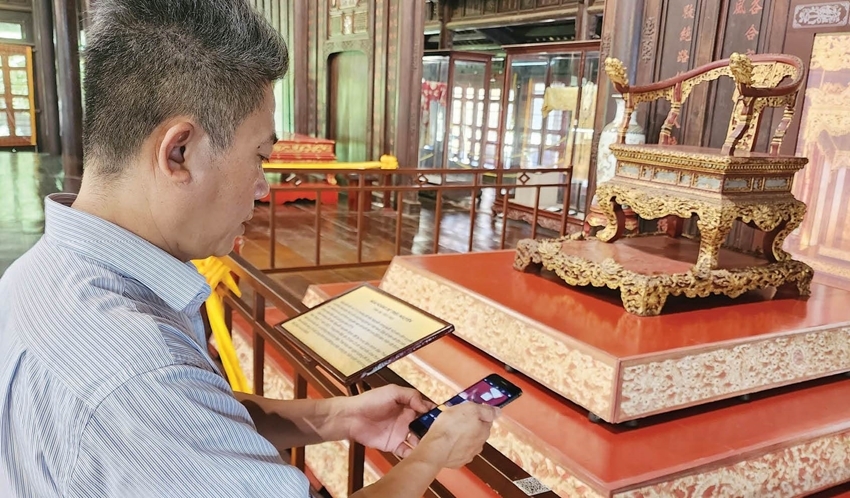 |
| QR code scanning application enables tourists to get full and fast access to information |
Special spaces
It is undeniable that thanks to the application of technology, the tangible and intangible cultural heritage has been increasingly able to connect, develop tourism, and keep pace with the trend. Technological application and heritage digitization not only solve the problem of remote experiences for people but also enhance the value of the destination.
After the Hue Monuments Complex was honored as a World Cultural Heritage (1993), the preservation and promotion of cultural heritage values have become a strategic orientation implemented in all fields: monument restoration, landscape conservation, scientific research, display - exhibition... The display and exhibition at the monument after restoration is an effort to return the "soul” to heritage, helping the monument truly "live" in the heart of the community.
Towards this goal, the display and exhibition activities at Hue heritage sites are done not only at a monument location or an architectural work, such as Long An Palace (Hue Museum of Royal Antiquities), Ta Tra (Dien Tho Palace - Royal Palace, Hue), Truong Sanh Palace, Thai Binh Lau (Place for the king to rest and sightsee), An Dinh Palace, shrines at the mausoleums of Nguyen dynasty kings..., but also at the larger spaces such as Truong Lang (Royal Palace), royal gardens...
Heritage brought closer to the public
In the Hue heritage area, the characteristics of the ancient architectural space have somewhat limited the application of modern technology in display and exhibition, but there have been several programs implemented and put into use, grabbing the attention of tourists. For example, the Hue Imperial Citadel Reconstruction Program using digital technology is carried out by the Korean Institute of High-Tech Science and Technology in collaboration with the Hue Monuments Conservation Center.
In particular, the monuments in Hue Imperial Citadel, especially Thai Hoa (Supreme Harmony) Palace, were scanned using digital technology in combination with animations and documentaries to vividly represent the sweeping images of Hue Imperial Citadel area...
In the period 2014 - 2016, Hue Monuments Conservation Center cooperated with La Rochelle University (France) in implementing the interpretation space of Hien Lam Cac (The monument in memory of the achievements of the Nguyen kings and the great mandarins). This is one of the initial activities for the application of modern technology in exhibiting and promoting information to tourists at the Hue heritage site, testing the French style, and combining modern equipment with artistic design based on traditional materials of Hue monuments.
In 2018, the Center for Information and Interpretation of Hue Imperial Citadel History and Virtual Reality Experience - "Seeking the Lost Royal Palace" came into operation within the framework of the business cooperation project between the Center and the IV Com Joint Stock Company in coordination with Korean partner in the eastern area of Thai Hoa (Supreme Harmony) Palace.
Also during this time, the VN Giude Program on digital museum-visiting experiences was piloted at Hue Museum of Royal Antiquities. Simultaneously, the Museum also installed QR codes in areas with the national treasures and at 2 exhibition points run by the unit (Long An Palace and An Dinh Palace) so that visitors can access the information fully and quickly.
“Currently, the Museum continues to apply technology in introducing antiques, using digital images combined with introducing real artifacts, by using interactive books - reading ancient books with digital devices instead of directly impacting the artifacts," informed Ms. Huynh Thi Anh Van, former Director of Hue Museum of Royal Antiquities.
Digitalization to spread
With the goal of applying digital technology to preserve cultural heritage in the 4.0 era, the digitization and storage of data for architectural works to serve the management, research, conservation, and restoration of heritage with digitalization technology become increasingly scientific and professional.
Director of Hue Monuments Conservation Center Hoang Viet Trung said that the Center has collaborated with many domestic and foreign organizations and units in carrying out the project of digitizing several monuments belonging to the Complex of Hue Monuments to strengthen the application of science and technology in digital technology to help improve the efficiency and accuracy of research, data storage, conservation and restoration of architectural monuments using 3D models...
“The effectiveness of these projects is shown in terms of advanced storage technology to help manage and preserve Hue monuments with 3D image models, propaganda, and promotion of Hue cultural values. In addition, these projects apply modern technology to popularize knowledge about history, culture, and architecture to people, especially young people who are entering adulthood, awakening their love for Hue and their awareness of the nation's cultural heritage protection," Mr. Trung said.
To date, the Hue Monuments Conservation Center has digitized more than 25,000 pages of Sino-Nom documents, 172 records (monument records, archaeological records, heritage records), 250 photos of ordination, 295 photos of poetry and literature on Hue imperial palace architecture; digitizing 2 works: Thai Hoa Palace and Hien Lam Cac; 206 artifacts/sets of artifacts, including 33 artifacts/sets of artifacts that are the national treasures, and 173 other artifacts/sets of artifacts. Currently, the center is preparing to 3D digitize all antiques and artifacts (about 10,000) belonging to the Hue Museum of Royal Antiquities to bring their values into play.
